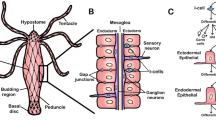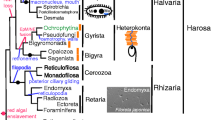Summary
Electron microscopic observations of the vegetative colony ofLabyrinthula clearly show that the “slimeways”, along which the cells glide, are extracellular and completely surround the cells. Membranes of this extracellular matrix have a trilaminar, unit membrane structure that is characteristic of the plasma membrane. The Golgi complex of the cells probably consists of two large dictyosomes. A membrane-limited bundle of parallel filaments of unknown function is usually adjacent to one dictyosome. Specialized invaginations of the plasma membrane, called bothrosomes, may be sites of membrane assembly and secretion of the “slimeway” matrix, the prerequisite substratum for the gliding cell movement.
Similar content being viewed by others
References
Bruni, C., andK. R. Porter, 1965: The fine structure of the normal rat liver. I. General observations. Amer. J. Pathol.46, 691–755.
Chadefaud, M., 1956: Sur unLabyrinthula de Roscoff. C. R. Acad. Sci. (Paris)243, 1794–1797.
Cienkowski, L., 1867: Über den Bau und die Entwicklung der Labyrinthuleen.Schultze's Arch. Mikroskop. Anat.3, 274–310.
Dangeard, P. A., 1932: Observations sur la famille des Labyrinthulées et sur quelques autre parasites desChladophora. Le Botaniste24, 217–259.
Fawcett, D. W., 1958: The structure of the mammalian spermatozoon. Int. Rev. Cytol.7, 195–234.
Fuller, M. S., andR. Reichle, 1965: The zoospore and early development ofRhizidiomyces apophysatus. Mycologia57, 946–961.
Hepler, P. K., andE. H. Newcomb, 1964: Microtubules and fibrils in the cytoplasm ofColeus cells undergoing secondary wall deposition. J. Cell Biol.20, 529–533.
Hohl, H., 1966: The fine structure of the slimeways inLabyrinthula. J. Protozool.13, 41–43.
Hollande, A., etM. Enjumet, 1955: Sur l'évolution et la systématique des Labyrinthulidae; Etude deLabyrinthula algeriensis nov. sp. Ann. Sci. Nat., Zool., 11me ser.17, 357–368.
Honigberg, B. M., W. Balamuth, E. C. Bovee, J. D. Corliss, M. Gojdics, R. P. Hall, R. R. Kudo, N. D. Levine, A. R. Loeblich, J. Weiser, andD. H. Wenrich, 1964: A revised classification of the phylum Protozoa. J. Protozool.11, 7–20.
Jepps, M. W., 1931: Note on a marineLabyrinthula. J. Marine Biol. Ass.17 (N. S.), 833–838.
Johnson, T. W., andF. K. Sparrow, 1961: Fungi in Oceans and Estuaries, 668 pp. Weinheim: J. Cramer.
Klie, H., undW. Schwartz, 1963: Untersuchungen über Lebensweise und Kultur vonLabyrinthula. Z. allg. Mikrobiol.3, 15–24.
Luft, J. H., 1961: Improvements in epoxy resin embedding methods. J. Biophys. Biochem. Cytol.9, 409–415.
Mollenhauer, H. H., andG. Whaley, 1963: An observation on the functioning of the Golgi apparatus. J. Cell Biol.17, 222–225.
Pokorny, K. S., 1967:Labyrinthula. J. Protozool.14, 697–708.
Porter, D., 1967: Observations on the cytology and motility ofLabyrinthula. 139 pp. Ph. D. Thesis, Univ. Washington.
Reynolds, E. S., 1963: The use of lead citrate at high pH as an electron-opaque stain in electron microscopy. J. Cell Biol.17, 208–212.
Schmoller, H., 1960: Kultur und Entwicklung vonLabyrinthula coenocystis n. sp. Arch. Mikrobiol.36, 365–372.
Smith, D. S., 1961: The organization of the flight muscle in a dragonfly,Aeschna sp. (Odontia). J. Biophys. Biochem. Cytol.11, 119–145.
Stey, H., 1968: Nachweis eines bisher unbekannten Organells beiLabyrinthula. Z. Naturforsch.23b, 567.
Valkanov, A., 1929: Protistenstudien 4. Die Natur und die systematische Stellung der Labyrinthuleen. Arch. Protistenk.67, 110–121.
Watson, S. W., 1957: Cultural and cytological studies on species ofLabyrinthula. 165 pp. Ph. D. Thesis, Univ. Wisconsin.
, andE. J. Ordal, 1957: Techniques for the isolation ofLabyrinthula andThraustochytrium in pure culture. J. Bact.73, 368–377.
Young, E. L., 1943: Studies onLabyrinthula; the etiological agent of the wasting disease of eel-grass. Amer. J. Bot.30, 586–593.
Zopf, W., 1892: Zur Kenntnis der Labyrinthuleen, einer Familie der Mycetozoen. Beitr. Physiol. Morph. Niederer Organismen2, 36–48.
Author information
Authors and Affiliations
Additional information
Portion of a dissertation submitted to the University of Washington in partial fulfillment of the requirements for the degree of Doctor of Philosophy in Botany.
Rights and permissions
About this article
Cite this article
Porter, D. Ultrastructure ofLabyrinthula . Protoplasma 67, 1–19 (1969). https://doi.org/10.1007/BF01256763
Received:
Issue Date:
DOI: https://doi.org/10.1007/BF01256763




